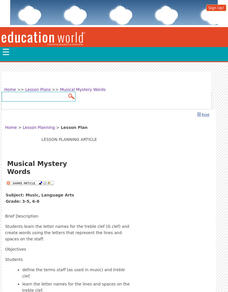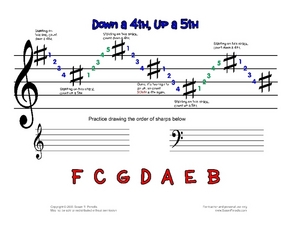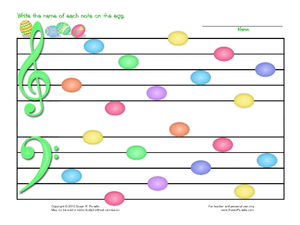Curated OER
Simple Sharps
If you want to play music, you need to learn how to read sharps and flats. Young musicians practice reading and playing these simple sharps. Each sharp is given a word that connects it to the note it is related to. For example: Charles...
Curated OER
Kindergarten Music Lesson
Singing, clapping, moving up and down with the melody, it all sounds like a great music activity. Kinder-musicians sing three different songs to practice memory, speaking, and movement skills. They'll move to the melody, build memory...
Curated OER
A Musical Accent Activity
Budding instrumentalists take on the task of reading accent marks and playing them correctly. They practice playing the provided rhythm or beat, focusing on emphasizing notes that have accents over them. The handout included provides...
Curated OER
Musical Mystery Words
Students study the letter names for the treble clef and create words using the letters that represent the lines and spaces on the staff.
Curated OER
Down a 4th, Up a 5th
It's time to practice those sharps. Young musicians write the order of sharps by counting down a fourth and up a fifth. This is a great way to teach sharps to emergent musical note readers.
Curated OER
Music Review Test
Wow this is a really thorough music quiz. There are a total of seven tasks for the class to complete. They must, write the C major scale, identify notes on the staff, write four major keys based on the information provided, identify...
Curated OER
Rhythm, Triads, Intervals
Let the class show what they know about rhythm, triads, and intervals with this quiz. They complete the rhythm on staff one and two, identify the intervals on staff three, and identify the triads on staff four. This is a well-thought-out...
Curated OER
Triads, Intervals, Keys, Note Values
Older or more advance musicians can test how well they can identify specific triads, intervals, keys, and note values with this quiz. Each staff focuses on one concept, they write the name of the triad, interval, or key.
Curated OER
Fearless Flats
This handout gives budding musicians an opportunity to practice placing and identifying notes and flats. A mnemonic is used to help them remember the names of each note as it appears on the staff.
Curated OER
Notes in the Fast Lane: Quiz
Here are four quizzes that cover note identification on the staff. Each page contains four sections, where the timed learners must identify and fill in the name of each note. These are titled as level 5, 6, 7, and 8, which implies that...
Curated OER
Triads - 7th Chords - Major/Minor Keys - Rhythm
Budding musicians transpose chords, identify major and minor keys, and complete measures to match the shown signatures. This resource can be used as a quiz, test, or as practice for those learning how to read and write music.
Curated OER
Putting Pitch In Its Place
Students focus on reading musical notations. They see, hear, practice and write notations in the lessons to become more independent readers of music. They complete a Rubric for Pitch Worksheet.
Curated OER
Math, Fractions, and Music
Students discover the relationship between musical rhythms and fractions. They add musical notes together to produce fractions and create addition and subtraction problems with musical notes. Students complete worksheets and create their...
Curated OER
Comparing Values: Comparisons Between Musical Notation and Money
Students identify ways in which the principles and subject matter of other disciplines taught in school, specifically math, are interrelated with those of music.
North Carolina Standard Curriculum
Rhythm Counting
Understanding time signatures and rhythm counting are two very important parts of playing an instrument well. Here are three basic lessons rolled into one that prompt upper graders to play their instruments with care. They'll practice...
Curated OER
Basketball Notes
Students add the value of various musical notes to win a chance to shoot a basketball. They compete in teams and consider the values of quarter, half and whole notes to complete related math problems.
Curated OER
Band Beats
Students discuss find out about the four types of musical instruments. They identify several instruments of each type. Students listen to a simple rhythmic music. They follow along with its notation. Students identify treble and bass...
Curated OER
Using Harmonic Vision’s Music Ace Software to Reinforce Basic Music Skills
If you have access to Harmonic Vision’s Music Ace Software, then this instructional activity could work for you. Kindergarteners use the video music software to place, identify, and read musical notes. They listen in and identify both...
Curated OER
Graphic Scores
You can write some music scores using images rather than musical notation. Kids learn how they can become musical composers by using graphics or images in place of musical notation. An interesting slide-show, but a more interesting...
Curated OER
Easter Egg Musical Notes
Pastel Easter Eggs are all over this staff, and it's up to your young musicians to analyze each one. They write the name of the note in each egg to practice identifying notes while reading music.
Curated OER
Timed Note Identification
Before you can play from sheet music, you need to be able to read it. This timed quiz requires the class to identify as many of the 90 notes as they can. Notes are on a staff in both treble and bass clef.
Curated OER
Melodic and Harmonic Intervals
If you are teaching music and need a resource to demonstrate melodic and harmonic intervals, you're in luck. This hand out describes and shows what melodic and harmonic intervals look like on a staff.
Curated OER
Treble Clef Lines - 2
In this treble clef lines worksheet, students read the sheet music and identify the letter names of the notes that are missing as they fill in 30 blank spaces.
Curated OER
Bass Clef Lines - 3
In this bass clef lines sheet music worksheet, students read the sheet music and identify the bass clef lines that are missing as they fill in 30 spaces.

























